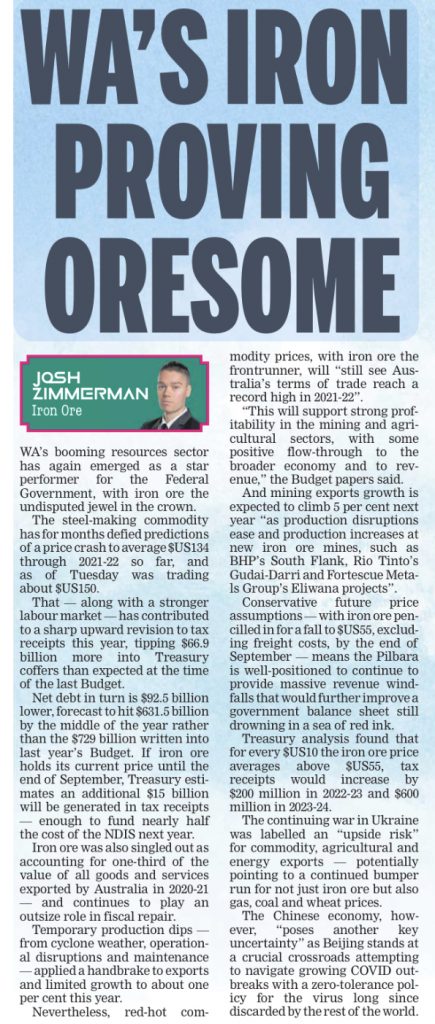
Article by Josh Zimmerman courtesy of the West Australian.

WA’s booming resources sector has again emerged as a star performer for the Federal Government, with iron ore the undisputed jewel in the crown.
The steel-making commodity has for months defied predictions of a price crash to average $US134 through 2021-22 so far, and as of Tuesday was trading about $US150.
That along with a stronger labour market has contributed to a sharp upward revision to tax receipts this year, tipping $66.9 billion more into Treasury coffers than expected at the time of the last Budget.
Net debt in turn is $92.5 billion lower, forecast to hit $631.5 billion by the middle of the year rather than the $729 billion written into last year’s Budget. If iron ore holds its current price until the end of September, Treasury estimates an additional $15 billion will be generated in tax receipts enough to fund nearly half the cost of the NDIS next year.
Iron ore was also singled out as accounting for one-third of the value of all goods and services exported by Australia in 2020-21 and continues to play an outsize role in fiscal repair.
Temporary production dips from cyclone weather, operational disruptions and maintenance applied a handbrake to exports and limited growth to about one per cent this year.
Nevertheless, red-hot commodity prices, with iron ore the frontrunner, will “still see Australia’s terms of trade reach a record high in 2021-22”.
“This will support strong profitability in the mining and agricultural sectors, with some positive flow-through to the broader economy and to revenue,” the Budget papers said.
And mining exports growth is expected to climb 5 per cent next year “as production disruptions ease and production increases at new iron ore mines, such as BHP’s South Flank, Rio Tinto’s Gudai-Darri and Fortescue Metals Group’s Eliwana projects”.
Conservative future price assumptions with iron ore pencilled in for a fall to $US55, excluding freight costs, by the end of September means the Pilbara is well-positioned to continue to provide massive revenue windfalls that would further improve a government balance sheet still drowning in a sea of red ink.
Treasury analysis found that for every $US10 the iron ore price averages above $US55, tax receipts would increase by $200 million in 2022-23 and $600 million in 2023-24.
The continuing war in Ukraine was labelled an “upside risk” for commodity, agricultural and energy exports potentially pointing to a continued bumper run for not just iron ore but also gas, coal and wheat prices.
The Chinese economy, however, “poses another key uncertainty” as Beijing stands at a crucial crossroads attempting to navigate growing COVID outbreaks with a zero-tolerance policy for the virus long since discarded by the rest of the world.